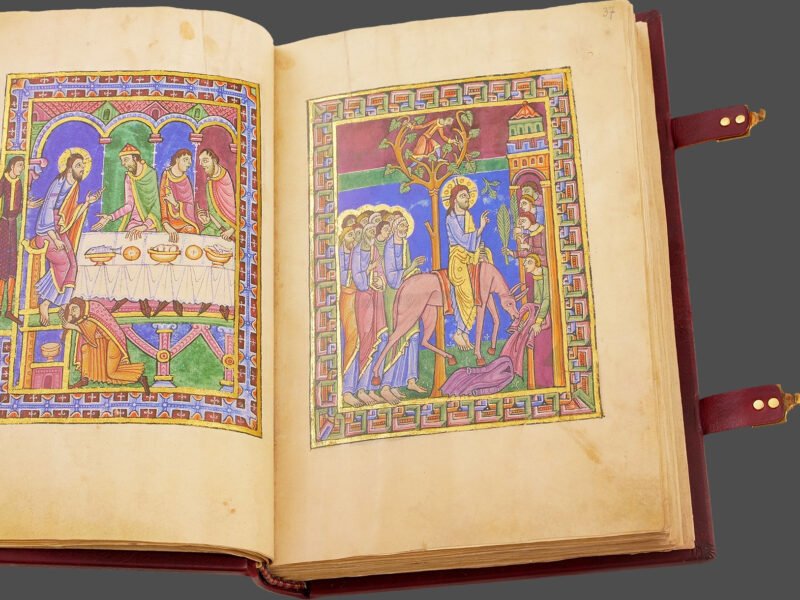While Watts and Wesley got an earlier start, the Church of England didn’t really begin its widespread use of hymnals until the mid-19th century. In part it was due to doctrinal reasons, in part due to cost, and partly because there weren’t any good Anglican hymnals. One of the earliest examples of the latter was Hymnal Noted (1851) by John Mason Neale, which introduced key medieval hymns to English language worship, including ”All glory, laud, and honor,” “O come, O come, Emmanuel,” and “Of the Father’s love begotten”.[1]
However Neale’s greatest influence was on subsequent hymnals, notable Hymns Ancient & Modern (1861), which combined Neale’s work with other Protestant hymns, new translations of medieval hymns, and the first stirrings of Victorian hymnody — as well as introducing the idea of a hymnal committee. A&M sold 8 million copies in its first four decades, and remains in print (in revised editions) to this day.[2] The English Hymnal (1906)— with Ralph Vaughan Williams as music editor – cemented that blend of medieval, ecumenical Protestant and uniquely Anglican hymns.[3]
In retrospect, 1851-2000 was the Golden Age of Anglican hymnody and hymnals. For many parishes today, hymnals are passé, killed by Contemporary Christian Music (CCM), projection screens, the Internet, or other factors. Ditching hymnals provides flexibility — particularly the option of using the latest praise song — but also drops the consistency of doctrine and worship that a standardized book can provide.
Today, it appears that local Anglican churches — or their senior pastors — have divided into two camps: those whose congregations sing hymns 52 weeks a year, and those where hymns make a token appearance at High Holy Days.[4] Consistent with my personal and research interests, the rest of this article is aimed at the former group. In particular, for American Anglicans it contrasts the two better-known hymnal options — The Hymnal 1982 and The Hymnal (1940) — with a new hymnal, Magnify the Lord, released in late 2019.
Existing Hymnal Options
Despite its ecclesial separation from the Church of England in 1789, the hymnody of the Episcopal church was heavily influenced by the CoE — with liberal borrowings from A&M and TEH. This influence can be seen clearly in The Hymnal (1916),[5] the first Episcopalian hymnal with a single authorized edition of texts and tunes.[6]
However, Episcopalian hymnody came into its own with the final two hymnals of the 20th century; for the past four decades, nearly all American Episcopal (or Anglican) churches have been using one of these hymnals. As with the 1916 hymnal, The Hymnal (1940)[7] was edited by Charles Winfred Douglas, arguably the most influential hymnologist in the history of the Episcopal church. H40 was a dramatic improvement over his 1916 predecessor, both for consolidating English borrowings and with original hymnody. However, what was most revolutionary was the detailed collection of 141 chants for the Eucharist and Daily Office service — the first Anglican hymnal (in the US or England) to incorporate such a collection.
H40 was updated twice, with Supplement I (1961) and Supplement II (1981). Most pew hymnals (and all new hymnals) include both supplements, which add the Benedictus to all the Sanctus chants, the familiar tune for “Joy to the World,” and many other small additions.
The Hymnal 1982 was highly influential as one of the earliest hymnals of the mainline Protestant denominations after the cultural revolution of the 1960s.[8] H82 was designed as a companion to the 1979 Book of Common Prayer, and thus offers its service music in both Rite I and Rite II, while shifting many hymns to contemporary language. Highly influential on its fellow “Seven Sisters” were the modernizations that provided an early round of gender neutered hymns, as when the “men” of John Mason Neale’s “Good Christian men, rejoice!” became “friends.”
Again, as with other aspects of the smorgasbord of American liturgies in use today, congregations have since sorted themselves out between three or four different camps (if they even use hymns): traditional language, modern language, modern language with some gendered neutering, and the latest and most cutting edge gender neutering. H40 is the first category, as is the 2008 Baptist Hymnal; the Lutheran Service Book (the 2006 LCMS hymnal) is the second category, while H82 is in the third. The final category corresponds to most mainstream Protestant hymnals of the past 25 years, beginning with The New Century Hymnal (1995) of the United Church of Christ, and continuing with more recent Presbyterian and Lutheran hymnals.
A New Hymnal for – If not by — the ACNA
While it has been talking about a hymnal revision for more than a decade, Hymnal 1982 remains the norm for most Episcopal churches. Instead, in the past 25 years, TEC produced a series of hymnal supplements — many targeting specific constituencies.
It is also the norm for the Anglican churches that broke away in the past two decades. Continuing Anglican churches — which rejected the 1979 prayer book — still use H40. However, the Reformed Episcopal Church — a jurisdiction within the ANCA — has now released its own hymnal, which is of potential interest to other Anglican churches throughout North America.
The new hymnal was originally released as Book of Common Praise 2017, a nod to the REC’s earlier 1943 hymnal of the same name. It comes from Anglican House Publishers, which has published various ACNA materials, including the Book of Common Prayer 2019 and To Be a Christian. In an effort to appeal to congregations outside the REC, in late 2019 Anglican House Publishers released a new edition of this hymnal, renamed as Magnify the Lord; beyond the first three pages, the content is identical.
The preface to MTL notes that while it is being offered to other ACNA parishes, the publisher is careful to state that it is not an official hymnal approved by the broader ACNA:
This is not the hymnal of the Anglican Church in North America. However, it has been commended for use in the Anglican Church in North America along with such other hymnals as are in use in the Province.
The hymnal editing process was representative of the REC, but not the ACNA (or other Anglican jurisdictions) beyond the REC. The hymnal committee was chaired by Chris Hoyt, then the music director of Holy Communion Dallas, today the cathedral of the REC Diocese of Mid-America. Despite the narrow pool of input, the committee was very conscientious in its efforts: the result is a 21st_century hymnal suitable for more traditional ACNA parishes (as those with hymns and organs tend to be).
Adding New Hymns
Despite its original title as continuing the REC-specific hymnal name, the preface to MTL by Rt. Rev. Ray Sutton states that the number one goal was “To preserve the best of The Hymnal (1940).” However, four of the seven remaining goals are to add hymns not found in H40.
Much as I love H40, I will eagerly stipulate it is missing many important hymns: by my count, as many as two dozen (subject of another article). The most obvious is “Amazing Grace,” perhaps the most popular Christian funeral hymn in the U.S. and U.K.[9] However, on Sunday morning, I am more likely to miss “Be thou my vision” or “Lift high the cross,” and newer tunes for familiar hymns — such as Azmon for “O for a thousand tongues to sing” or Repton for “Dear Lord and Father of mankind.” MTL corrects more than 15 of these major omissions.[10]
Other hymns missing from H40 are perhaps more controversial. An example is the Catholic folk hymn “Bread of Life,” loved for its quotation of John 6 but criticized (if not ridiculed) for its unconventional voice leading and arrhythmic meter; it is not included in MTL.
At the same time, MTL makes a conscious effort to represent other Protestant hymn traditions. This can be particularly important in those regions or Anglican congregations where a large fraction of members were raised in other Protestant traditions: as with any church music, this childhood music will have strong associations for the believer.
MTL includes 20 hymns by Charles Wesley, adding six not found in H40. It includes 19 hymns by Isaac Watts, with five not found in H40. From Southern Harmony (1835), it includes eight hymns — with two by Watts*:
- Christ hath a garden walled around*
- Come, ye sinners, poor and needy
- Guide me, O thou great Jehovah
- In the name which earth and heaven
- Lord of Glory, who hast bought us
- My Shepherd will supply my need*
- Savior, breathe an evening blessing
- What wondrous love is this, O my soul, O my soul!
It also includes two from Sacred Harp (1844): “Come, all Christians, be committed” and “Wash, O God, our sons and daughters,” as well as other Protestant staples such as “Come, thou Fount of every blessing” and “Great is thy faithfulness.”
Where MTL is unique among these three hymnals is its final goal, “To incorporate a representative number of contemporary worship hymns which are well-formed in music, theology, and poetry.” It includes seven contemporary-style hymns written or co-written by Stuart Townend, son of a West Yorkshire Anglican vicar. This includes two solo pieces by Townend from 1995 and 2005, and five collaborations with Keith Getty from 2001-2009, the best known being “In Christ Alone” and “Speak, O Lord.” While often performed by the same churches that use other CCM songs, these pieces are more hymn-like in their style and theology, and thus distinct from songs like “10,000 Reasons” or “Shine, Jesus Shine.”
Service Music
Most REC parishes use traditional language liturgy, either the 1928 Book of Common Prayer, or the 2005 REC Book of Common Prayer that includes both the 1928 and 1662 Eucharistic liturgies. MTL keeps some (not all) of the service music from H40 and the Rite I portions of H82.
It has three traditional language mass settings from both — John Merbecke’s Common Praier Noted (1550), Healey Willan’s Missa de Sancta Maria Magdalena (1928), and Winfred Douglas’ Missa Marialis (1915) – as well as a 2016 setting by Hoyt. For each, it includes the Kyrie (three-fold and nine-fold), Sanctus (with or without Benedictus), Agnus Dei, and Gloria.
However, reflecting its ACNA orientation, it adapts the Hurd New Plainsong (1981) from H82 to the liturgy of the ACNA’s 2019 Book of Common Prayer. It is the first (and AFAIK, only) hymnal to include a mass setting for BCP2019.
It also provides the traditional language Scottish Gloria found in both H40 and H82, but not the Sanctus from Schubert’s Deutsche Messe (a Rite II setting in H82). Reflecting Hoyt’s passion for Simplified Anglican Chant, it includes 12 four-part settings and it includes a four-page tutorial on how they can be used for chanting psalms.
Other Changes
MTL also undoes what I consider to be two problems of H82. First, H82 eliminates many of the congregational harmonies from H40. MTL not only reverses that trend, but also adds harmonies where none was provided by either previous hymnal (some more singable than others).
Second, for those of us with less great eyes — or sitting in low light — the tiny notes of H82 are hard to read. MTL, like the Lutheran Service Book (2006), makes a conscious effort to use larger and more readable notes.
Finally, MTL also improves on H40 by making a conscious effort to print the words under the notes, which is particularly important for part-singing. As a policy, the hymnal lists the text with the music for the first five verses, while H40 typically stops after three verses.
Conclusions
Changing a hymnal can be contentious if not traumatic. The adoption of a new hymnal is easier for new parishes, or ones that don’t already have a standard hymnal.
While MTL was written by the REC, its use is by no means limited to it. I have repeatedly worshiped at the first parish outside the REC to use it — Christ Church, Waco, in the Diocese of Ft. Worth, which adopted the hymnal nearly two years ago.[11] As its rector, Father Lee Nelson told his parish before their debut:
It’s funny today to think that hymn-singing could ever be viewed as the activity of ordinary Christians, because the norm has become something of a performance — worship music performed by experts. Surely, something has been lost in this. Something which we should try to recover. …
In the initial phases of conversion, so much hinges on our objective experience of things. But, if we are to grow in Christian discipleship, we must take on a new vocabulary, one not our own. We must relocate that subjective experience within the living witness of the Church. To do so requires lending our voices to others, both in supporting their voices, but also in singing their words. When we sing the words of John Wesley, or Isaac Watts, or even the Gettys, we say for a moment, we submit our own understanding to the wisdom of the whole communion of Saints.
We have to consciously work to blend our voices, keeping our own at bay. This requires a degree of humility and attention to the whole body of gathered believers. …
It’s a sad fact, but it’s true, that Sunday mornings are just about the only time when ordinary people come together and sing. … Hymns are a sign of a people who are at peace with each other, a people in whom the word of Christ dwells richly, overflowing with thanksgiving and praise. When people of various backgrounds, incomes, and educations sing together, it is an eschatological sign, not only of what will be but of what God has done now, what has been realized among believers today.
Footnotes
- Joel W. West, “Neale’s Hymnal Noted and its Impact on Twentieth-Century American Hymnody,” The Hymn, 69, 3 (Summer 2018): 14-24, ↑
- For a thorough summary, see Richard William Wilkinson, “A History of Hymns Anceint and Modern,” unpublished Ph.D. thesis, University of Hull, March 1985. URL: https://hydra.hull.ac.uk/assets/hull:8304a/content ↑
- Alan Luff, ed. Strengthen for Service: 100 Years of the English Hymnal, 1906-2006. (Norwich: Canterbury Press, 2005). ↑
- In my experience, most churches that attempt to do a blended service are too small or too poor to do separate services. Most healthy churches that I’ve visited will pick one or other, or do their best to offer a quality, respectful version of each. ↑
- The copyright has expired on the 1916 hymnal, and it is thus available free online at the Internet Archive at https://archive.org/details/ahymnalasauthor01churgoog ↑
- For example, the 1892 had six different privately-published editions, using different tunes for the same officially approved texts. See The Hymnal 1940 Companion, 3rd ed. (New York: Church Pension Fund, 1951): xxiv, and Leonard L. Ellinwood and Charles G. Manns, “The Publication of the Hymnal of the Episcopal Church,” in Raymond F. Glover, ed., The Hymnal 1982 Companion, Volume I, (Church Publishing: New York, 1990): 49-76. ↑
- The dates of the hymnals and prayer books of the Episcopal church tend to be the dates they were approved, not the actual date they first appeared in print. ↑
- The first such hymnal was the Lutheran Book of Worship (1978) from the precursors of the Evangelical Lutheran Church in America. However, by today’s standards the modernizations were mild — in part because the hymnal was a joint project between the future ELCA and the more conservative Lutheran Church–Missouri Synod. See Ralph W. Quere, “Liturgy, Unity, and Disunity: The Context and Legacy of LBW.” Currents in Theology and Mission 30, 5 (October 2003): 349-365. ↑
- For a critique of hymns suitable for an ecumenical American funeral, see Joel W. West, “Through Death to Life: Selecting Ecumenical Hymns for a Lutheran Funeral,” Logia: A Journal of Lutheran Theology 29, 2 (April 2020): 19-27. ↑
- Many will be pleased to see Abbot’s Leigh for “Glorious things of thee are spoken,” but in terms of singability, Taylor’s tune can’t improve upon Haydn’s harmonies — even if Austria had unfortunate overtones in 1941. ↑
- “21st century hymnals come to Waco,” Anglican Music weblog, September 2, 2018, URL: http://anglicanmusic.blogspot.com/2018/09/21st-century-hymnals-come-to-waco.html ↑







'Hymnal Choices for North American Anglicans' have 2 comments
June 5, 2024 @ 12:32 pm Tom Sikora
Can you tell me if “A Prophet Woman Broke A Jar” is in any Anglican hymnals?
January 8, 2025 @ 6:29 pm David
According to Hymnary.org, it is in Common Praise (1998), which is a hymnal of the Anglican Church of Canada.